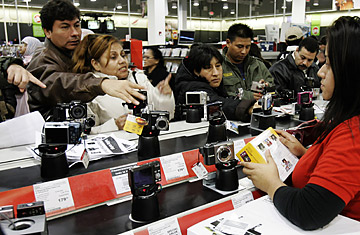
Shoppers look at digital cameras on display at a Circuit City electronics store in North Bergen, N.J.
(2 of 2)
One big problem with letting your buying be swayed by specs is that your underlying preferences likely don't change along with your purchase decisions — and so you wind up at home with things that don't make you as happy. In one experiment, researchers presented two cell phones, and told subjects that one had a more vivid screen. Some subjects were also told that model A had a vividness value of 1,800, compared to model B's score of 600. Everyone was then asked to rate on a 7-point scale both how much they liked phone A and how likely they were to buy it. The people who were given the numerical spec rated their chances of buying phone A much higher (an average 5.6 compared with 4.1 for the control group), even though the two groups rated how much they liked the phone just about the same.
In another experiment, the researchers gave people two bowls of potato chips. Type A was thicker than type B; the experimental group was told type A was 1.5 millimeters thick, while type B was 0.8 millimeters. As expected, once people were given the exact measurements, they much more often said they'd choose to buy type A — 51% of the time, compared with 37% for the control group. Yet when people were given the two bowls of chips and told to eat however much of whichever type they'd like, the two groups ate type A at practically the same rate — indicating that people liked the thin chips just as much as the thick chips, even though they were more likely to buy the thick ones.
So how do you make sure you listen to your true preferences when you're at the mall? "First of all, consumers should experience the product before they look at specifications," says Hsee. "Sometimes marketers use a big font, but we should try to ignore it." Reading about how many coils a mattress has only after you've laid on it for a while should keep your decision-making more in line with your real perception of comfort.
Another strategy: avoid comparison shopping. In a store, you're likely to compare the specs of one flat-screen TV to the next, even though at home only the absolute experience matters, not the relative one. In your family room, whether the screen is 42" or 46" might not be nearly as big a deal as how easy the remote is to use. You'll get a better feel for the overall experience of each TV if you look at one and then leave the store for a few minutes before coming back in to look at the next. And if it turns out the thing that was attracting you to the 46" was how nice that number sounded and nothing more, then you might just save yourself some money in the process.
